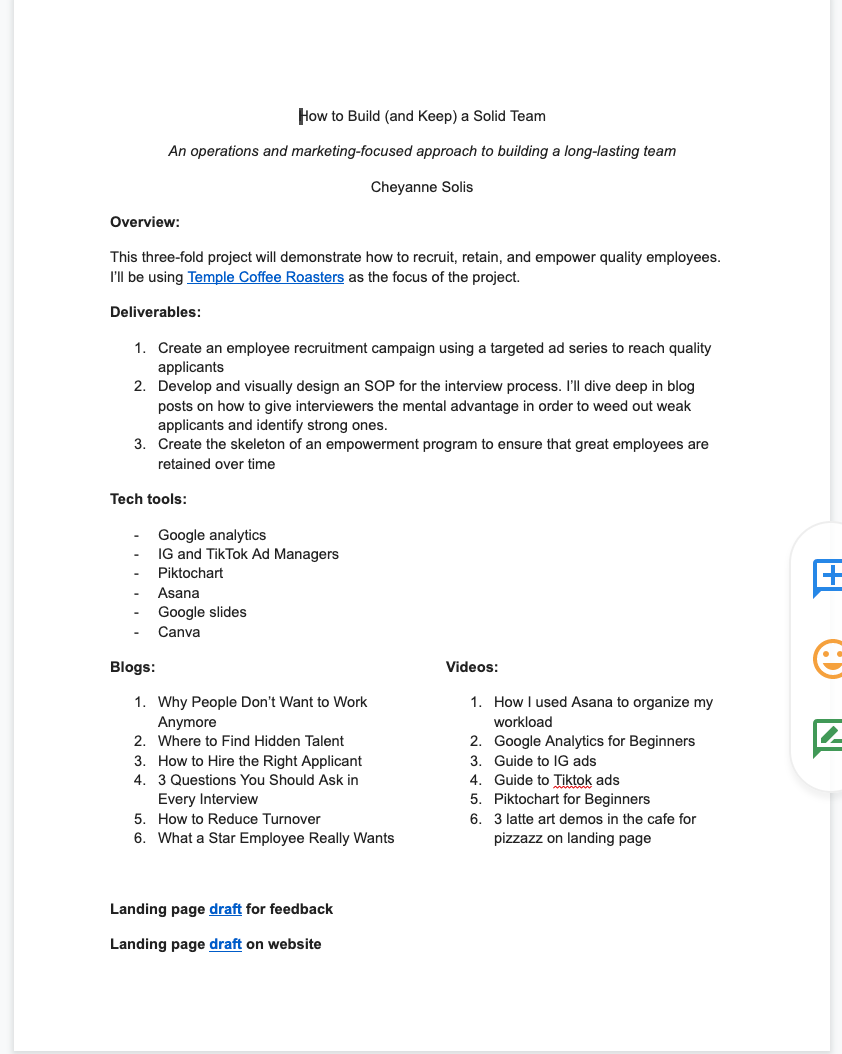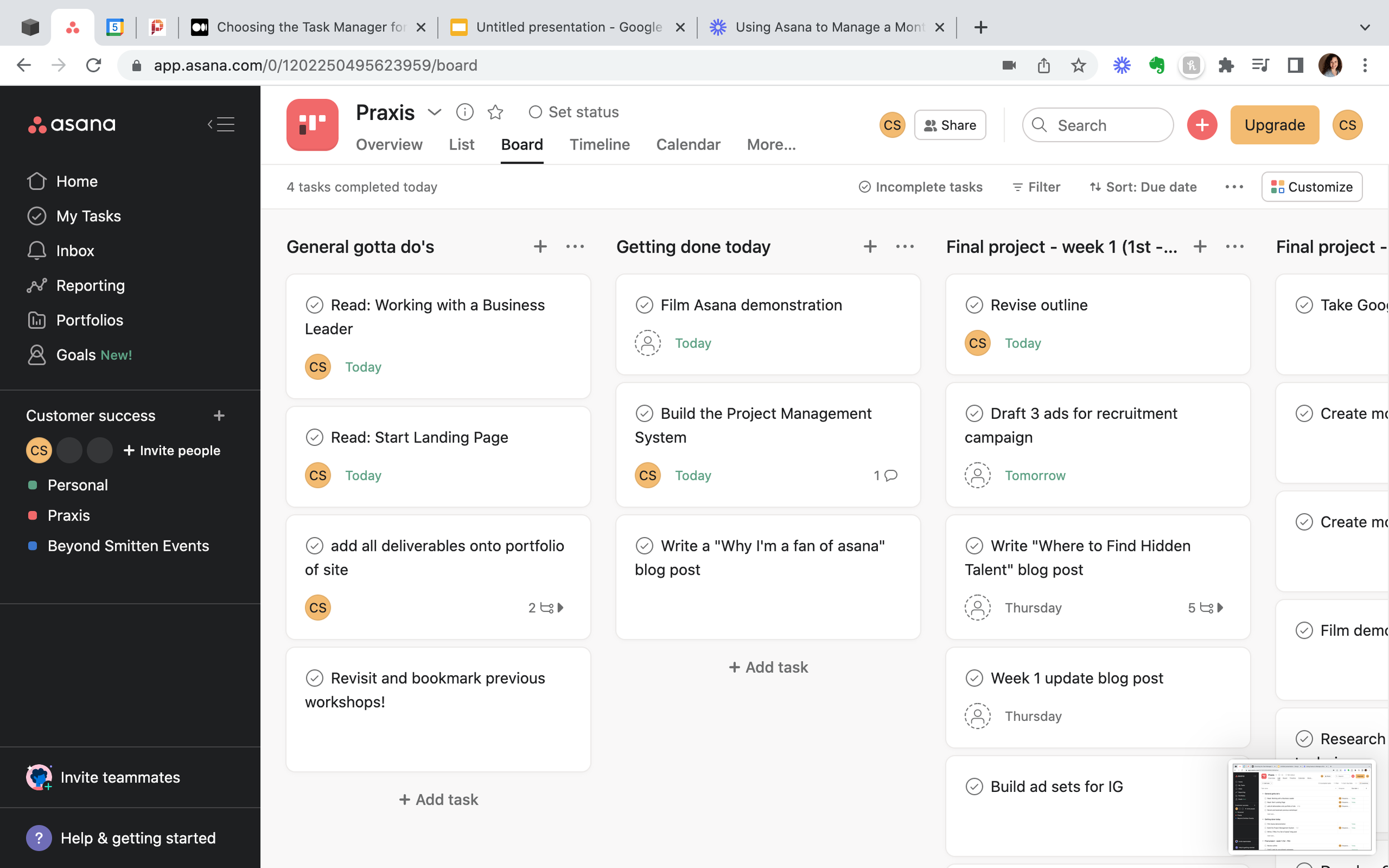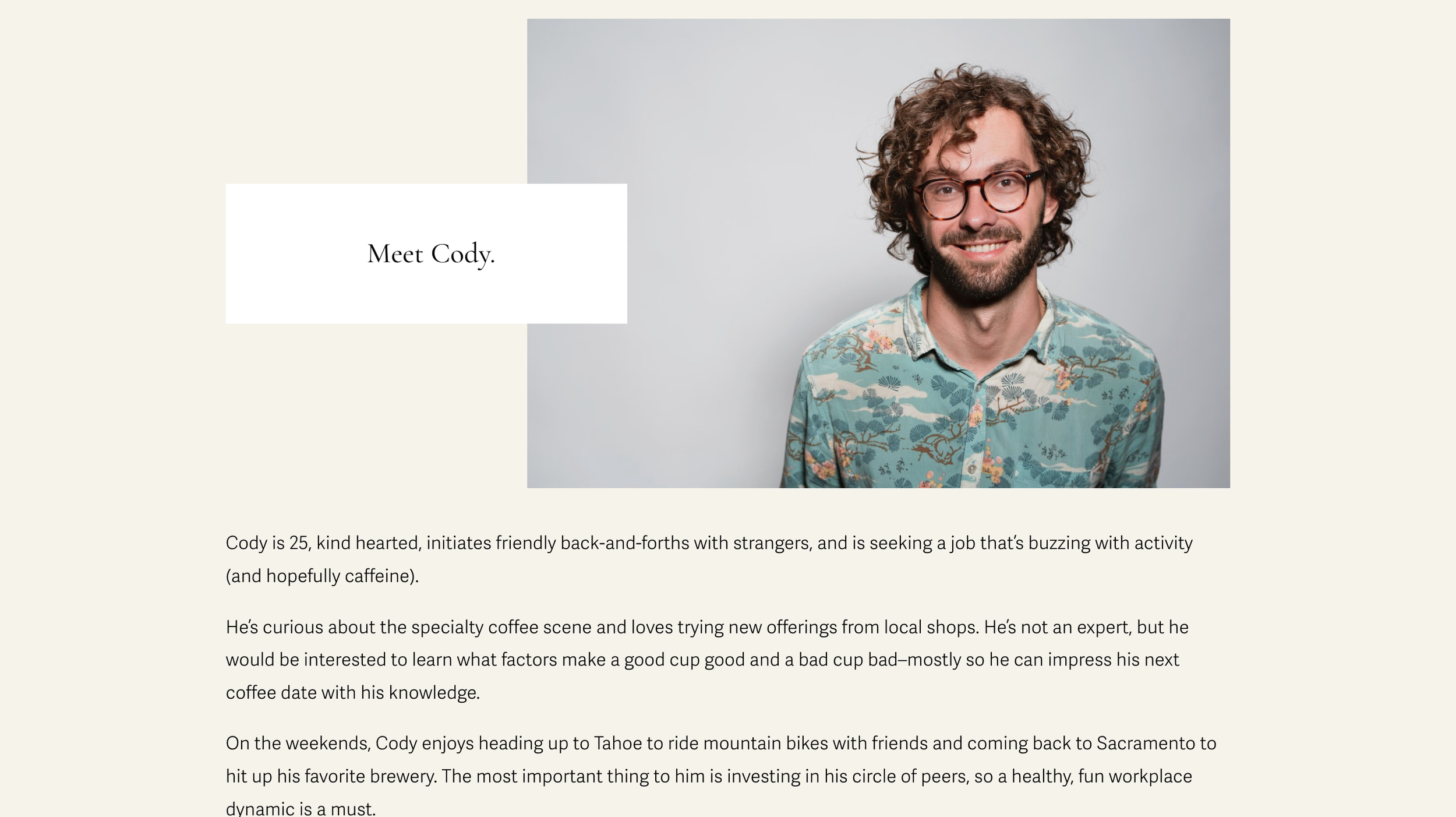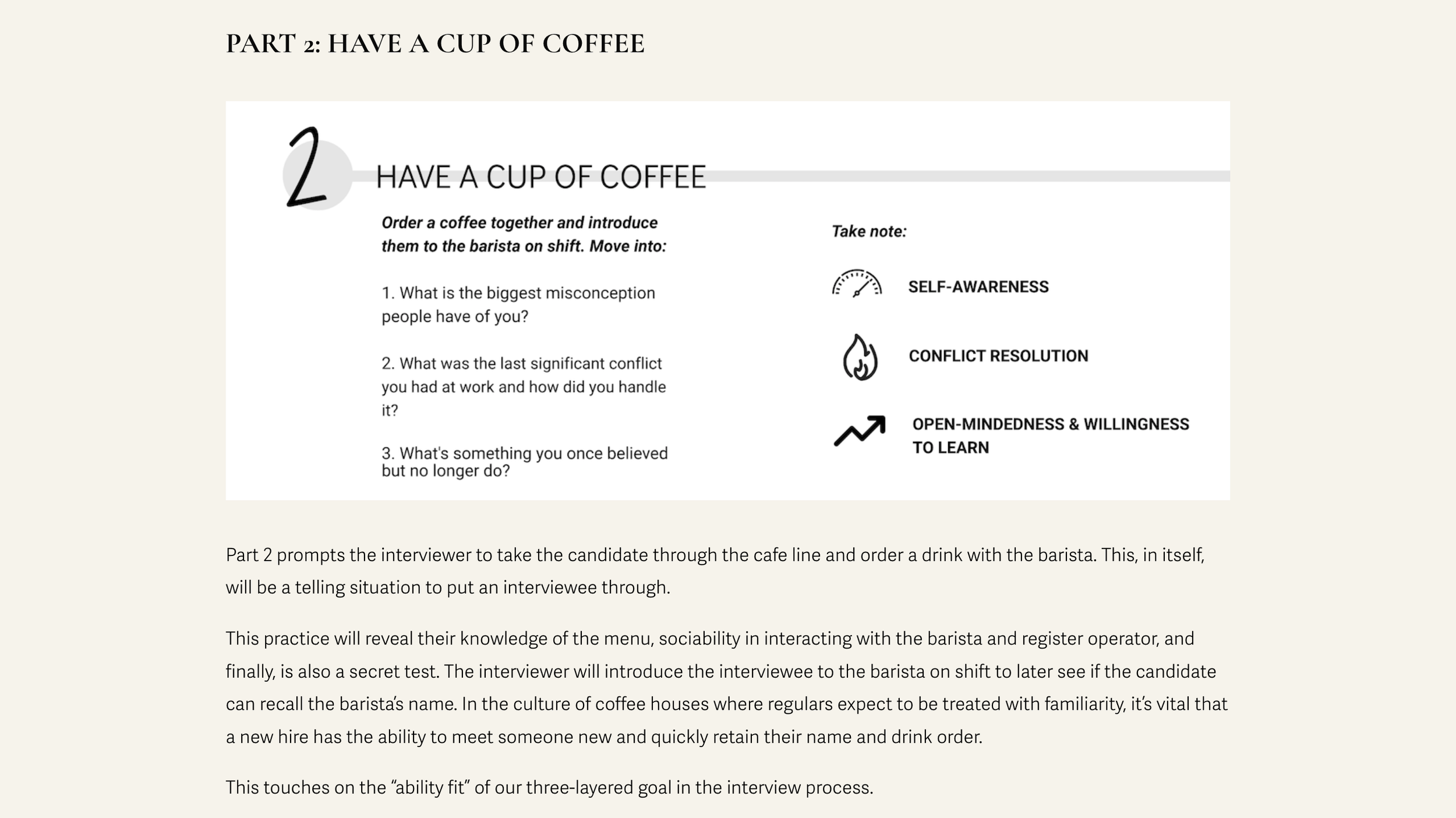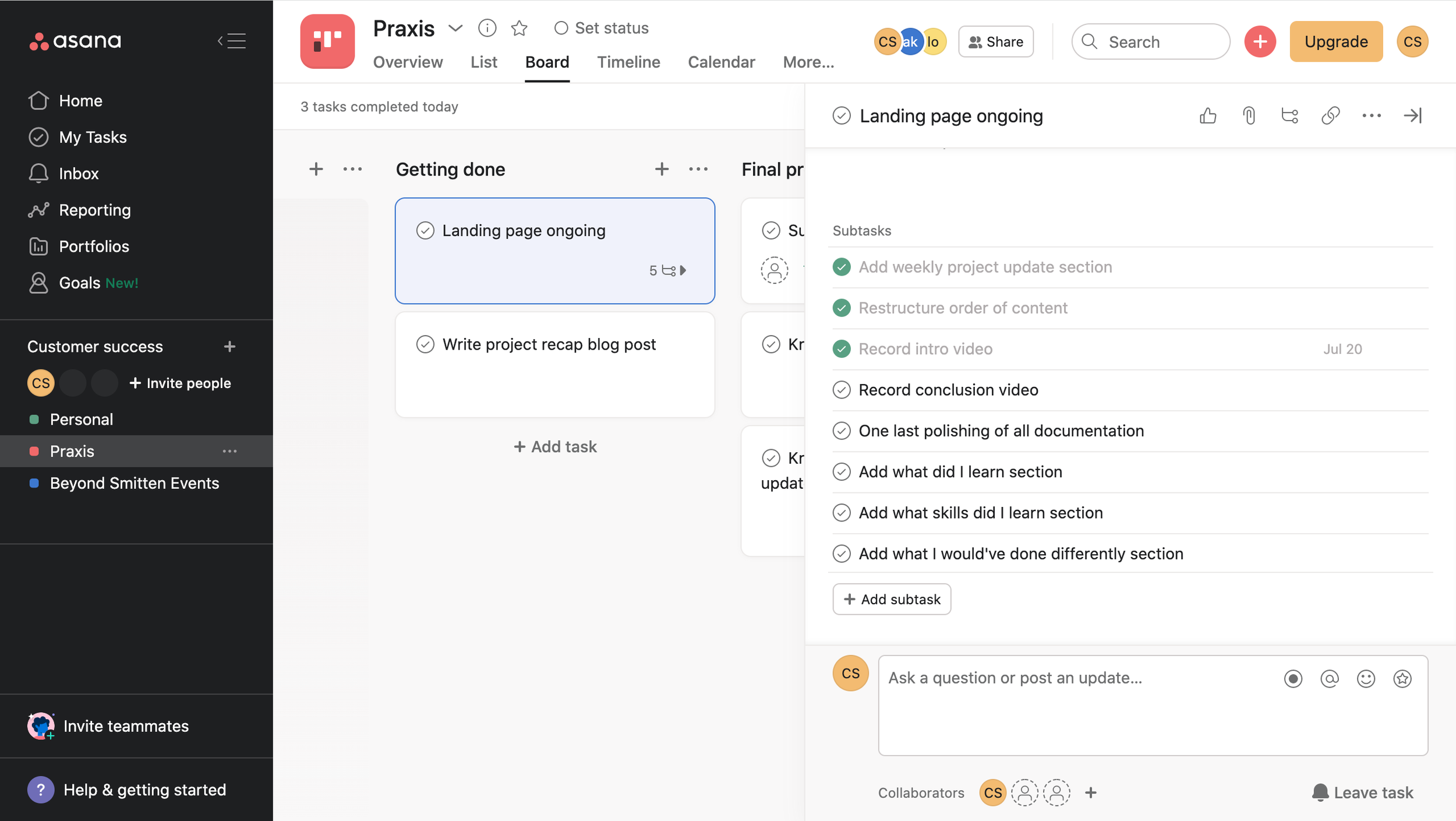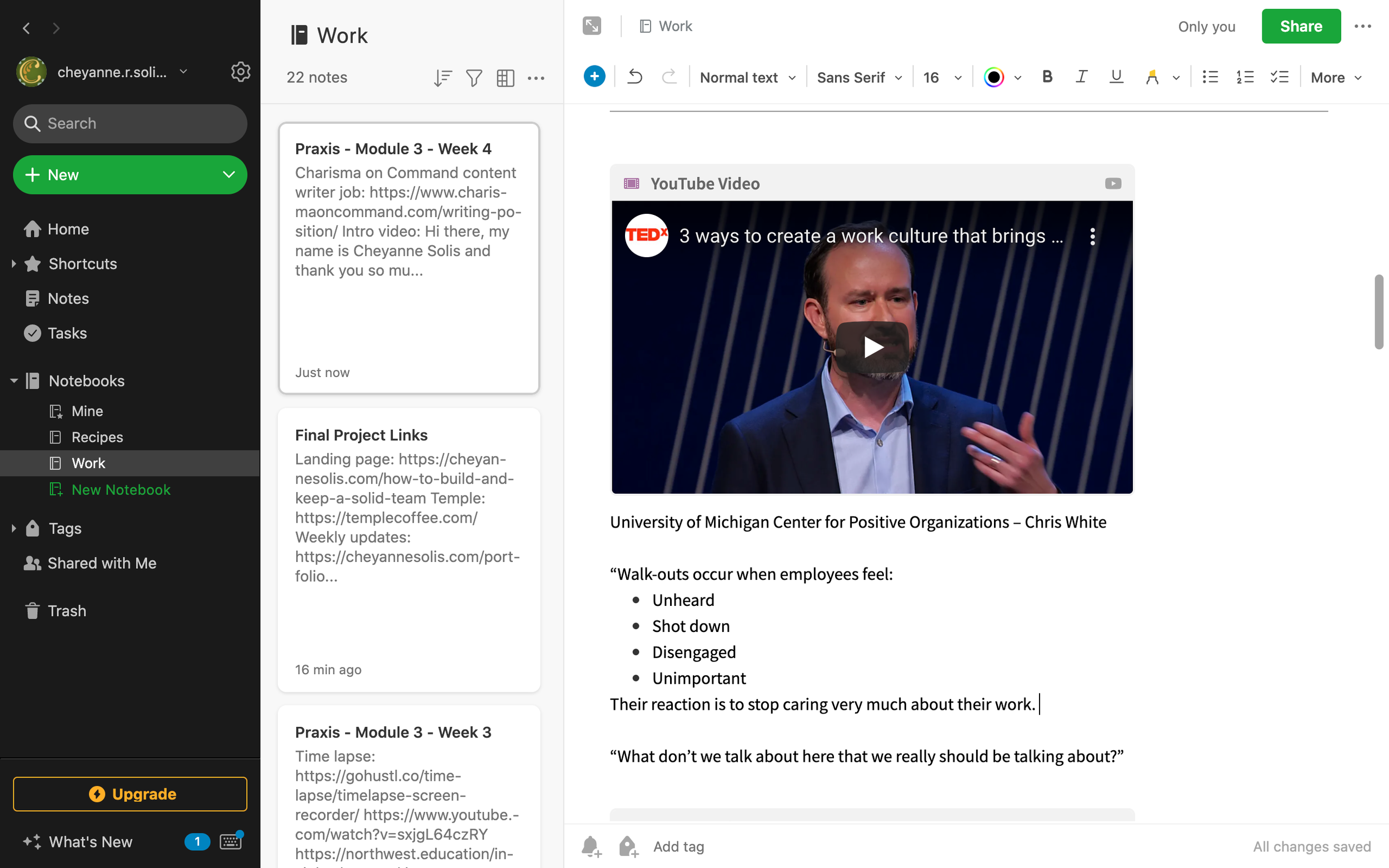30 Days of Team-Building: A Summary of How I Did It
Of my own accord, I independently created these project pieces to test my professional skills and expand my knowledge and experience. I was not hired or paid to complete this work.
I took 30 days to create the building blocks of recruiting, retaining, and empowering quality team members for a Sacramento favorite, Temple Coffee Roasters.
Put simply, my goals were to:
RECRUIT: Create an employee recruitment campaign using a targeted ad series to reach quality applicants
Why? Working in the service and hospitality industry all throughout the pandemic, I’ve watched The Great Resignation unfold across the US. I have seen the profound power shift occur between employee and employer. Times are changing and passive listings thrown on job boards won’t reel in the quality applicants quality companies need.
I wanted to explore a model in which employers can flip the script on tradition recruitment, and offer an intentional method in which we “market a position” to our target candidate in the same way we’d “market a product” to our target audience.
RETAIN: Develop and visually design an SOP for the interview process
Why? What if you could go beyond a resume and decode the true motivations and character of a prospect for hire? To achieve this, I design a Standard Operating Procedure that cleverly employed the use of psychology-backed research to “decode an applicant.”
As a member of a small tight-knit team myself, I understand the loss of momentum and blow to morale a high turnover rate can have on an organization. Not only is it time-consuming and costly to train someone just to have them leave, but it puts unnecessary stress on the staff that now has to work overtime to pick up the slack.
I worked to create a better way of interviewing that went beyond the glance of a resume or asking a few run-of-the-mill questions.
EMPOWER: Create the skeleton of an empowerment program to ensure that great employees are retained over time
Why? I recognize that a company could find a stellar applicant, go through a seamless interview and onboarding process, and still lose that team member at the end of the day. Why? A few of the top reasons why people leave their jobs are workplace toxicity, disengagement, and under-appreciation. And again, in light of The Great Resignation, companies are beginning to realize they need to step it up if they are to retain their labor.
But this offers an incredible opportunity!
With the concluding piece of my project, I wanted to explore my theory of how “a company is only as healthy as the team that’s running it” and I offer practical applications and guidance to companies looking to enhance their health and retain their people.
Keep scrolling to have a look at all I was able to accomplish in 30 days.
FIRST THINGS FIRST
Before taking a whack at any project piece, I needed a task management system to keep me on track. I employed the use of 3 tools to organize my thoughts, time, and tasks.
I used Asana as my task manager.
Google Calendar to organize my time blocks.
And, I used Evernote—my second brain—to track research, notes, and project links.
After developing an outline and deciding what the nuts and bolts of this project would look like, I broke down the elements into weeks 1 through 4 in my task manager.
WEEK 1: planning, outlining, recruitment
Week 1 was a birds-eye view week—planning, outlining, and breaking down tasks into bite-size chunks.
After planning, I moved into my first thought piece entitled: “Why People Don’t Want to Work Anymore” where I set the tone for why shifting our recruitment strategies as companies is necessary if we want to stay afloat in the changing tides of the workforce.
“The power dynamic has rightfully shifted, and this leaves a massive opportunity for businesses to begin marketing their positions to reach the quality individuals they want. ”
WEEK 2: targeted ad series
Heading into Week 2, I began building out the components of the recruitment portion of my three-layered project with a targeted ad series. Here, I offer my demonstration company, Temple Coffee Roasters, an outlined ad series and accompanying avatar of what I researched to define as their “ideal candidate,” Cody.
With the ideal candidate in mind, I created 3 ads, ad copy, and detailed their intentions.
Finally, I taught myself Meta for Business to demonstrate how I’d go about setting up these ads to reach the eyes of our ideal applicant audience across Facebook’s family of apps.
Before Week 2 was up, I dug into the recruitment topic with an additional blog post: “A Hot Take: Job Boards” and began moving into the retainment portion of my project with a blog post entitled: “3 Refreshing Approaches in an Interview.”
“Conducting your talent acquisition like a marketing campaign will help you reach your ideal pool of applicants. Essentially, you proactively weed out weak candidates by not casting the net in their direction in the first place.”
WEEK 3: standard operating procedures for recruitment and retainment
Making my way into Week 3, I educated myself on the psychology-backed techniques of behavioral interviewing, employee retainment, and team empowerment to inform my operational project pieces.
Now that we attracted our ideal applicant with our targeted ad series, I wanted to equip hiring staff with the resources to Identify star prospects for their team and a step-by-step guide in doing so.
First, I created a Standard Operating Procedure for Temple Coffee’s interviewing process using Piktochart—my favorite visual creating software.
I break down each section, explaining the clever psychology tricks embedded in each of the prompts.
In order to build a team with intentionality, I provide the means by which recruiters can rely on more than their gut feeling and a resume with this Standard Operating Procedure.
I demonstrate how I used Piktochart to create the engaging visual of this SOP:
In an effort to reduce turnover and costly hiring mistakes, I explore these concepts with a blog post entitled: “Reduce Turnover with Speed Reading” where I walk through how to become a “speed reader” as an interviewer.
Here, I make the case for a more intentional strategy to interviewing and providing a science-backed solution to hiring managers.
“Hiring managers cannot afford to neglect the story behind nonverbal cues in an interview setting.”
Next, I moved onto creating a Standard Operating Procedure to aid managers in maintaining and developing their team members. I framed the SOP as a monthly check in procedure, again with psychology-based reasoning on each of the steps that I outline.
I wanted to, again, establish the components necessary in fostering health in a team setting and provide a consistent procedure to aid management in the development of their team members.
I recorded a time-lapse piecing together this engaging visual on Piktochart:
WEEK 4: keep a team that will last
In Week 4, I tightened up the bolts of my project and dove headfirst into the meatiest of all my blog posts over the course of the month with a piece entitled: “Fostering a Team to Last.” This was by far the deepest dive I took into researching and absorbing all the information I could on what makes up a long-lasting team.
“Carefully curated talent will spoil in the unfavorable conditions of a workplace lacking trust and safety.”
In addition to polishing documentation, I completed a formal landing page housing all my project details and reflected on how this project evolved and how it stretched me to grow.
Here are my biggest takeaways:
#1 — TIME MANAGEMENT IS KING
Without a plan, I wouldn’t have made it across the finish line this month. A detailed outline, trusty task management system, and a consistent dedication to seeing each week through was by far the most important tool to completing this month’s project.
As a wedding coordinator, I thought I had the “planning thing” down pat. I inherently understand that without a map to follow and without forethought, things fall apart quickly. But this lengthy project stretched me to grow that skill even more.
My Asana task manager and Evernote acted as second brains, progress trackers, and organizers for me. This month proved the old saying: “Fail to plan, plan to fail.” And while doing the administrative work to take my project outline, input weekly tasks into my task manager, and then break down those tasks into further subtasks took a significant amount of time, it was time incredibly well-spent.
I learned this month that project management amounts to nothing without time management.
#2 — THE PROOF IS IN THE PUDDING OF RESEARCH
It took me a few weeks to discover, but week 3 brought me to the revelation that my best work comes out of the overflow of deep, unencumbered research.
Previously, I only researched out of necessity—to find and cite sources that fell in line with what I was working to create to add validity—and I tried to complete that step of the process as quickly as possible. In an effort to pump out first drafts and keep on track with my timetables for the week, I limited how much I allowed myself to really dig into the material.
However, by week 3, I realized how essential it is to give myself room to fall into fascination with the topics I’m covering. I began to let what I discover not just inform my opinions, but add depth and value and richness to them.
As I read articles, watched videos, and scoured resources, I used Evernote to capture all the information I was absorbing for reference and accessibility later on.
I refined my personal process of capturing links and quoting important statistics or thoughts, organizing it all to add breadth and complexity to my project pieces.
#3 — I’M MORE CONVINCED THAN EVER THAT…
I tackled this team-building project on the notion that “A company is only as healthy as the team that’s running it.” I noted this in my intro video of this project as I shared how I sought to explore that concept and essentially, see if it held any water from the research.
Turns out, it does!
As I dug into research and created these project pieces, I’m more convinced than ever that the health of a company directly correlates to the health of its team. In my professional experience, regardless of pay rate, benefits, perks, or the company mission itself, if workplace toxicity is present, the ceiling is set low for everyone. What I uncovered in the statistics and especially in the context of the growing Great Resignation of the US, I am not alone in that belief.
In light of this real-world phenomenon, I set out to create the building blocks of recruiting, retaining, and empowering quality employees. I believe everyone has something unique to offer and if a workplace could act as an environment that recognized that value and brought it out, imagine the magic that would unfold!
In essence, 30 days digging into team-building and retention stretched my abilities, challenged my capacity, and offered me opportunity to discover what really creates a team health that lasts.
For a whole overview of all I accomplished in 30 days, explore here.


